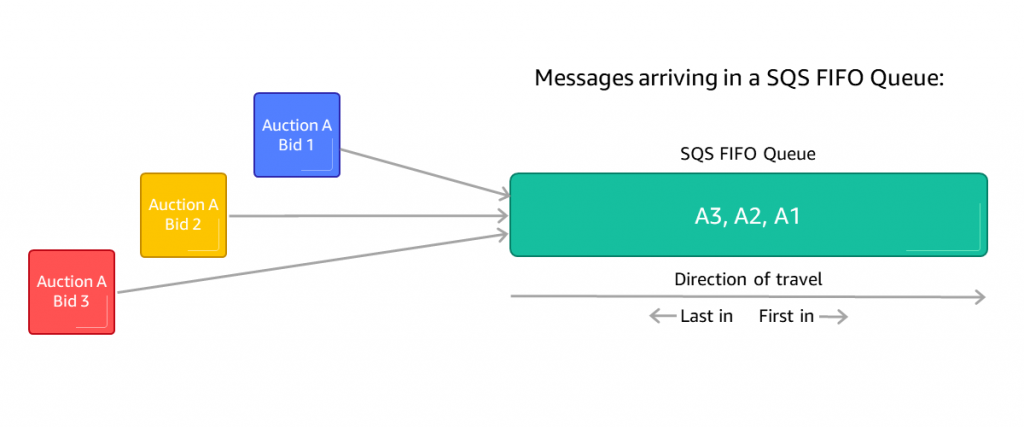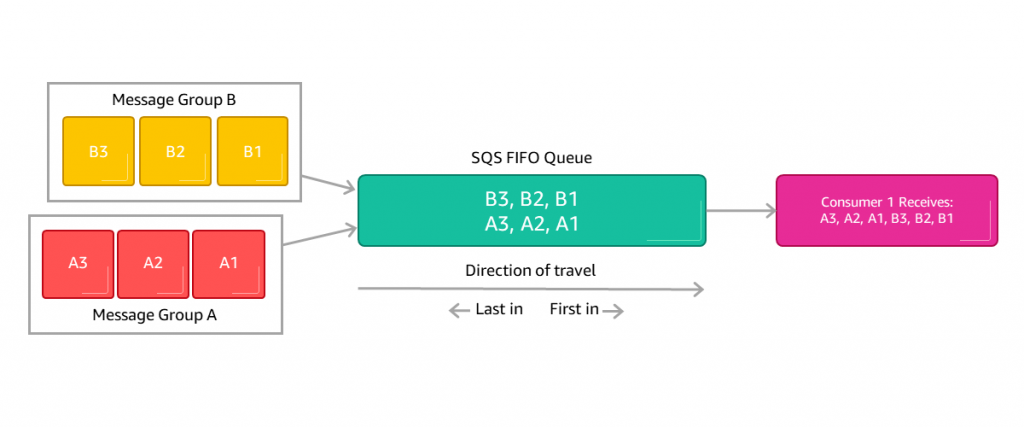AWS Compute Blog
Solving Complex Ordering Challenges with Amazon SQS FIFO Queues
Contributed by Shea Lutton, AWS Cloud Infrastructure Architect
Amazon Simple Queue Service (Amazon SQS) is a fully managed queuing service that helps decouple applications, distributed systems, and microservices to increase fault tolerance. SQS queues come in two distinct types:
- Standard SQS queues are able to scale to enormous throughput with at-least-once delivery.
- FIFO queues are designed to guarantee that messages are processed exactly once in the exact order that they are received and have a default rate of 300 transactions per second.
As customers explore SQS FIFO queues, they often have questions about how the behavior works when messages arrive and are consumed. This post walks through some common situations to identify the exact behavior that you can expect. It also covers the behavior of message groups in depth and explains why message groups are key to understanding how FIFO queues work.
The simple case
Suppose that you run a major auction platform where people buy and sell a wide range of products. Your platform requires that transactions from buyers and sellers get processed in exactly the order received. Here’s how a FIFO queue helps you keep all your transactions in one straight flow.
A seller currently is holding an auction for a laptop, and three different bids are received for the same price. Ties are awarded to the first bidder at that price so it is important to track which arrived first. Your auction platform receives the three bids and sends them to a FIFO queue before they are processed.
Now observe how messages leave the queue. When your consumer asks for a batch of up to 10 messages, SQS starts filling the batch with the oldest message (bid A1). It keeps filling until either the batch is full or the queue is empty. In this case, the batch contains the three messages and the queue is now empty. After a batch has left the queue, SQS considers that batch of messages to be “in-flight” until the consumer either deletes them or the batch’s visibility timer expires.
When you have a single consumer, this is easy to envision. The consumer gets a batch of messages (now in-flight), does its processing, and deletes the messages. That consumer is then ready to ask for the next batch of messages.
The critical thing to keep in mind is that SQS won’t release the next batch of messages until the first batch has been deleted. By adding more messages to the queue, you can see more interesting behaviors. Imagine that a burst of 11 bids is sent to your FIFO queue, with two bids for Auction A arriving last.
The FIFO queue now has at least two batches of messages in it. When your single consumer requests the first batch of 10 messages, it receives a batch starting with B1 and ending with A1. Later, after the first batch has been deleted, the consumer can get the second batch of messages containing the final A2 message from the queue.
Adding complexity with multiple message groups
A new challenge arises. Your auction platform is getting busier and your dev team added a number of new features. The combination of increased messages and extra processing time for the new features means that a single consumer is too slow. The solution is to scale to have more consumers and process messages in parallel.
To work in parallel, your team realized that only the messages related to a single auction must be kept in order. All transactions for Auction A need to be kept in order and so do all transactions for Auction B. But the two auctions are independent and it does not matter which auctions transactions are processed first.
FIFO can handle that case with a feature called message groups. Each transaction related to Auction A is placed by your producer into message group A, and so on. In the diagram below, Auction A and Auction B each received three bid transactions, with bid B1 arriving first. The FIFO queue always keeps transactions within a message group in the order in which they arrived.
How is this any different than earlier examples? The consumer now gets the messages ordered by message groups, all the B group messages followed by all the A group messages. Multiple message groups create the possibility of using multiple consumers, which I explain in a moment. If FIFO can’t fill up a batch of messages with a single message group, FIFO can place more than one message group in a batch of messages. But whenever possible, the queue gives you a full batch of messages from the same group.
The order of messages leaving a FIFO queue is governed by three rules:
- Return the oldest message where no other message in the same message group is currently in-flight.
- Return as many messages from the same message group as possible.
- If a message batch is still not full, go back to rule 1.
To see this behavior, add a second consumer and insert many more messages into the queue. For simplicity, the delete message action has been omitted in these diagrams but it is assumed that all messages in a batch are processed successfully by the consumer and the batch is properly deleted immediately after.
In this example, there are 11 Group A and 11 Group B transactions arriving in interleaved order and a second consumer has been added. Consumer 1 asks for a group of 10 messages and receives 10 Group A messages. Consumer 2 then asks for 10 messages but SQS knows that Group A is in flight, so it releases 10 Group B messages. The two consumers are now processing two batches of messages in parallel, speeding up throughput and then deleting their batches. When Consumer 1 requests the next batch of messages, it receives the remaining two messages, one from Group A and one from Group B.
Consider this nuanced detail from the example above. What would happen if Consumer 1 was on a faster server and processed its first batch of messages before Consumer 2 could mark its messages for deletion? See if you can predict the behavior before looking at the answer.
If Consumer 2 has not deleted its Group B messages yet when Consumer 1 asks for the next batch, then the FIFO queue considers Group B to still be in flight. It does not release any more Group B messages. Consumer 1 gets only the remaining Group A message. Later, after Consumer 2 has deleted its first batch, the remaining Group B message is released.
Conclusion
I hope this post answered your questions about how Amazon SQS FIFO queues work and why message groups are helpful. If you’re interested in exploring SQS FIFO queues further, here are a few ideas to get you started:
- Create an Amazon SQS FIFO queue with three simple commands in the SQS console
- Explore another use case for FIFO queues in our blog, Using Python and Amazon SQS FIFO Queues to Preserve Message Sequencing
- Learn more about how Amazon SQS FIFO queues work in the Amazon SQS Developer Guide





